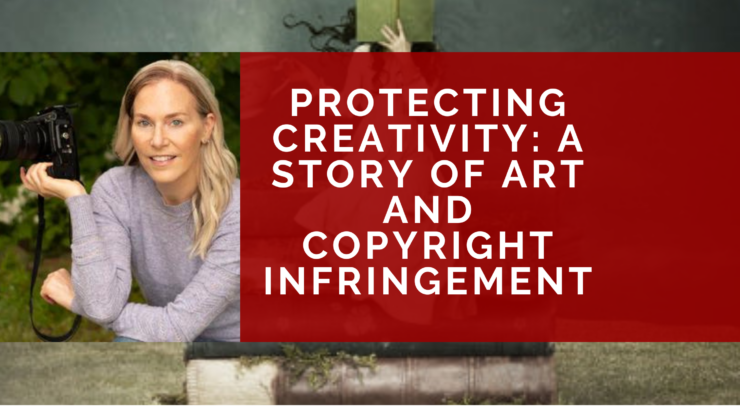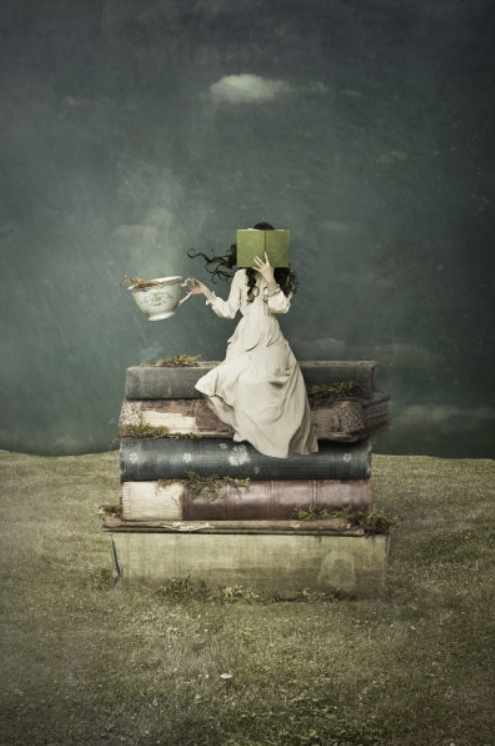
As the owner of Xanadu Gallery, I often come across stories of artists facing challenges in their creative journeys. We represent one such artist at Xanadu Gallery, Elisabeth Ladwig, whose experience with copyright infringement has been both frustrating and inspiring. Today, I want to share her story and the lessons we can learn from her tenacious fight to protect her artwork.
When Elisabeth reached out to me, she inquired if I had written any blog posts about copyright infringement. Although I hadn’t covered the topic before, I was familiar with artists who had faced similar issues. I shared stories of sculptors engaged in multi-year lawsuits against companies copying their work. These conversations sparked an idea: why not write a blog post about copyright infringement and invite the art community to share their experiences and strategies for resolution?

| Photo Collage/Watercolor Paper |
24″h x 16″w
Elisabeth’s battle against copyright infringement began when she discovered her artwork being unlawfully reproduced and sold on platforms like Amazon, Mercari, and Artmajeur. The audacity and extent of the infringement left her dumbfounded. It was evident that the sellers may have unknowingly purchased stolen art, prompting Elisabeth to feel empathy toward them rather than seeking retribution.
To address the issue head-on, Elisabeth followed the steps outlined in the Digital Millennium Copyright Act (DMCA). She reached out to the sellers, explaining the situation and referencing her copyright registration number. Some sellers ignored her, while others promptly removed the listings upon realizing the infringement.
While Mercari posed some challenges, with one seller blocking Elisabeth and reporting her to the platform, she persisted. Elisabeth reported both sellers to Mercari, resulting in the removal of the listings and warnings for the sellers. On Etsy, a platform known for supporting creatives, Elisabeth contacted three sellers directly, all of whom cooperated and took down the listings without any resistance.

One notable incident occurred on Artmajeur, where someone had created a painting inspired by Elisabeth’s work. A friend of hers took it upon herself to comment on the listing, raising awareness about piracy. The seller repeatedly deleted the comments, leading Elisabeth to report the listing. Although the page remained, the image was removed with a copyright warning, highlighting the importance of accurate descriptions and disclaimers.
Throughout her journey, Elisabeth maintained a realistic outlook. She understood that completely eradicating piracy might be challenging, akin to playing a never-ending game of whack-a-mole. However, she didn’t lose hope. Elisabeth received helpful advice from her friend Darren Hudson Hick, the author of “Artistic License: The Philosophical Problems of Copyright and Appropriation,” who highlighted some of the challenges that come in trying to deal with these kinds of copyright infringement issues and made suggestions about how she should proceed.

Elisabeth’s persistence paid off. She reported five infringing Amazon listings, and after a few days, Amazon removed them. This victory with such a large corporation brought a sense of relief and fueled her confidence in protecting her artwork.
Fighting piracy can be an emotional journey. Elisabeth decided to break down the process into manageable weekly tasks, stepping away from it as needed. She reflects that while it’s natural to feel anger and an urge to go all-in trying to put a stop to the theft, it’s worth taking a moment to consider how the piracy is affecting your business and manage your time accordingly. [In her case, many of the products being sold online were created from low-resolution images and not something her client base would likely purchase.]
“It’s wrong, it’s frustrating, and you wonder how people sleep at night in good conscience,” she says, “But all that aside, it’s also important to stop and assess how much, or how little, the piracy is impacting your business. There has to be a balance. For artists, fighting piracy shouldn’t overtake time spent on creative endeavors.”
Elisabeth’s experience serves as a reminder of the significant challenges artists face in the digital age. It emphasizes the importance of raising awareness, supporting fellow artists, and exploring strategies to safeguard creative work.
If you find yourself in a situation similar to Elisabeth Ladwig’s, where your artwork has been subjected to copyright infringement, it’s essential to have a well-defined process in place. While each case may vary, the following suggestions can help guide you through the steps to address copyright infringement effectively:
- Gather Evidence: Start by collecting evidence of the infringement, such as screenshots, URLs, or any other relevant information that proves your ownership of the original artwork. This evidence will be crucial when communicating with the infringing parties and platform administrators.
- Contact the Infringing Parties: Reach out to the individuals or businesses selling your artwork without permission. Be professional and clear in your communication, explaining the infringement, providing your copyright registration number if applicable, and requesting the immediate removal of the infringing listings. Approach the situation with empathy, acknowledging that they may have unknowingly purchased stolen art.
- Reference Copyright Laws: Familiarize yourself with the copyright laws applicable to your country, such as the DMCA in the United States. Reference these laws in your communication to educate the infringing parties about the legal consequences they may face if they fail to comply with your request.
- Report to Platform Administrators: If the infringing listings remain after contacting the sellers, report the copyright infringement to the administrators of the respective platforms where the art is being sold. Most online platforms have specific processes and forms for reporting copyright violations. Provide all the necessary details and evidence to support your claim.
- Engage Legal Support: Consider consulting with a lawyer who specializes in intellectual property and copyright law. They can provide guidance, draft cease and desist letters, or help you explore further legal action if necessary. Legal professionals can offer personalized advice based on your specific circumstances and jurisdiction.
- Follow Up and Monitor: Regularly check the platforms where the infringement occurred to ensure that the listings have been removed. Keep records of your communication with the infringing parties, platform administrators, and any other relevant parties involved. Maintain a vigilant approach, as some infringers may attempt to re-upload the listings or continue their activities under different usernames. You can use services like reverse-image searches to help find infringing products.
- Share Your Story: Consider sharing your experience, as Elisabeth has. Sharing your journey can create awareness and encourage dialogue within the art community. Other artists may provide insights, tips, or even connect you with resources to combat copyright infringement effectively.
Remember, addressing copyright infringement can be a complex and sometimes lengthy process. Stay persistent, seek support from fellow artists and legal professionals, and continue advocating for the protection of your creative work. By taking proactive steps and raising awareness, you contribute to a safer and more respectful artistic environment.
Have you experienced copyright infringement or faced similar challenges? We want to hear from you! Share your thoughts, experiences, and strategies for combating infringement in the comments section below.
Remember, the fight against copyright infringement is ongoing, but through awareness, education, and support, we can create a safer and more respectful environment for artists to thrive.
